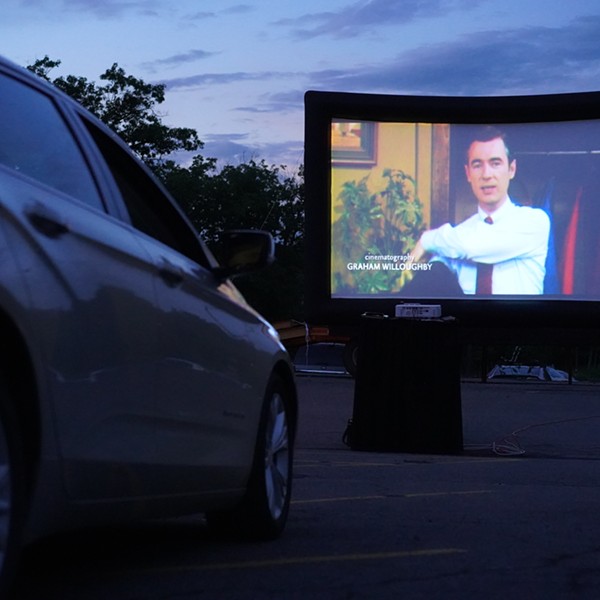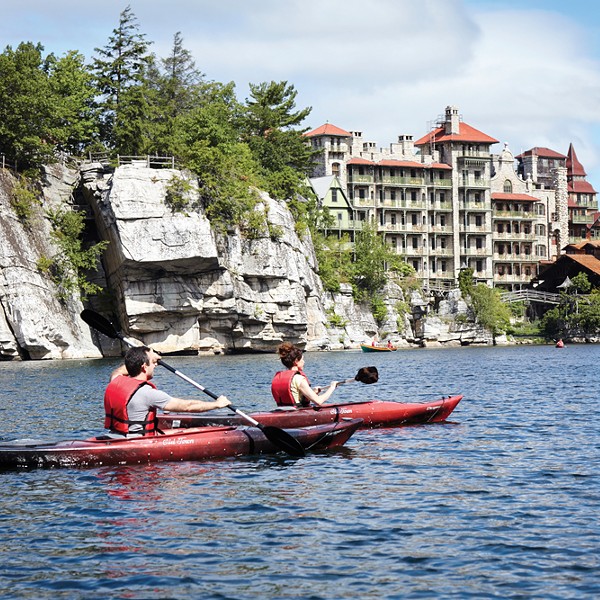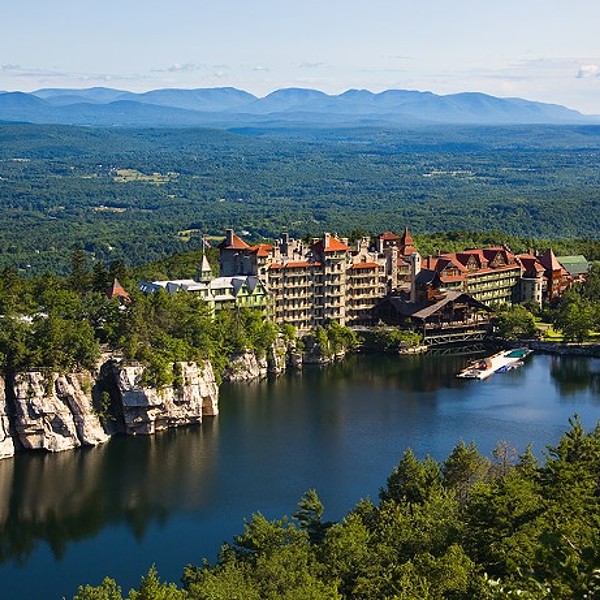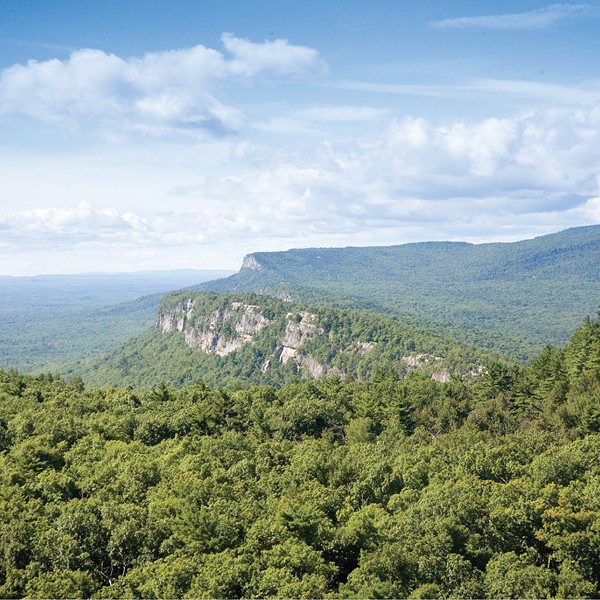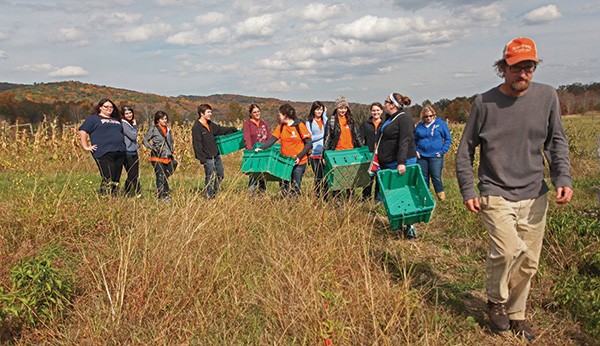
Editor's Note, 1/23/14: This article has been revised for accuracy.
Some people have no sense of irony.
In June of 2011, Mohonk Mountain House sold approximately 874 acres of its land to the Open Space Institute (OSI), the land preservation organization where former Mohonk Preserve board member Robert K. Anderberg is vice president and general counsel.
This transaction was part of a much lager foothills preservation initiative that’s been in the news the past few years, the stated purpose of which is to protect land close to the Shawangunks from development.
Almost immediately upon acquiring the land, OSI offered a lease to about 340 acres to an organization to which it’s closely related, called Glynwood Institute. Described by Harvard University as “one of the nation’s leading sustainable agriculture and food organizations,” it does its best to present that image.
Glynwood and OSI are funded from the same pot of gold—the Wallace Foundation, created from the profits of Reader’s Digest.
If you read Glynwood’s literature, you hear about how its mission is to encourage community-based agriculture. You’ll see pictures of horses pulling a plough, guided by young people, and greenhouses, and barns, and idyllic scenes of rural life the way things used to be.
Glynwood has plans to start up a number of farming incubator projects on the acreage it will be leasing from, all of which in theory are designed to help encourage the farmers of the future.
As it turns out, there’s already a working farm on the land that Glynwood is leasing, called the Brook Farm Project. A CSA (community-supported agriculture project), it’s been there for 10 years. After making many improvements to the land and farmhouse over the past decade, Brook Farm is a thriving community that by some miracle broke even in the 2013 growing season.
Glywnwood, for all its ideals, plans to commence its relationship to the community by kicking out an actual organic, community-supported farm run by young people—the very thing it says that it supports. In June, Brook Farm Project was informed by OSI, in the person of Robert Anderberg, that it would be shut down.
Brook Farm is a source of food for New Paltz families, a place for people interested in farming to work the land, and a place to meet others who have bonded into an extended family. Its farm stand near The Bakery in New Paltz had become a friendly summertime fixture.
A community meeting called by the Friends of the Brook Farm Project was held in October, which packed Deyo Hall with people concerned about the conduct of local land trusts and the closely related Glynwood Institute.
Among the facts that came out: Brook Farm takes up just 20 acres of the 323 acres that Glynwood will be leasing. Unless there’s some huge divergence in mission, values or purpose, one would think that the two projects could coexist in a mutually productive way. Three hundred and twenty-three acres is more land than most local farmers can imagine, and is just one part of Glynwood’s land holdings.
Before I go any further, I have a question. How come every time I write an article mentioning OSI and the name Robert Anderberg, someone else is getting kicked out of their home or off of their land? Is this some coincidence, or is there a pattern?
At the October 2 community meeting in support of Brook Farm, a man named Guy Jones, an organic farmer, told this story. Seven years ago, Anderberg approached Jones, saying OSI wanted a working farmer on a tract of land in Orange County that the organization was willing to sell to him.
“Farming is all we do for a living,” he said, knowing he would be the perfect tenant. But he was still skeptical. He said OSI came on like a buddy and persuaded him to take the offer—$300,000 for 110 acres, and they would hold the mortgage. “At closing they banged me for another 100 grand plus a mandatory donation,” Jones said to the group of 75 Brook Farm supporters. Still, Jones became OSI’s poster child for organic farming, even appearing on the cover of the organization’s annual report.
OSI sold Jones a balloon mortgage, meaning that he would make interest payments, then pay off the principal at the end of the mortgage. When the balloon payment came due two years ago, Hurricane Irene struck and Jones lost $250,000 worth of crops in the flooding.
Despite the obvious hardship, OSI would not renegotiate the mortgage, Jones explained. “They said ‘Give us all the money or get the fuck out’. They wouldn’t even talk. I owed them the last month’s interest and I was hoping to wrap that into a new mortgage. But they foreclosed and then they sued me for the last month’s interest.”
“Then they resold the property. They flipped it. They sold it for $400,000 cash.”
“These guys are bullies,” Jones warned the supporters of Brook Farm Project, referring to OSI. “They’re not nice people and they’re not going to negotiate. They’ve got the title and they’re just going to drive it. They don’t need to listen to anyone.”
That much is true. Brook Farm organizers say they have been left out of all the significant discussions, and that OSI and Glynwood officials have refused to attend their meetings.
Creek Iversen, who heads the farm, was put under a gag order by the Brook Farm board, which led to the resignations of three Brook Farm board members in protest—gardening columnist Lee Reich, Culinary Institute of America instructor Rich Vergili, and Dan Getman, a local attorney.
“Recently, the board has not functioned as a board should—by consensus or majority rule,” they wrote in a resignation letter signed by all three.
“Each of us also wishes to dissociate ourselves from the recent joint public statement released by BFP [Brook Farm Project], OSI, and Glynwood, as well as from statements made to Creek Iversen dictating his activities apart from the work for which he was hired. Neither of these activities were authorized by the board, though they purported to be issued under that authority. And they contravened the board’s instructions. We cannot be part of a board that is treated in this way.”
Those involved with Brook Farm and the organizations supporting it say that Anderberg is directly involved in calling the shots, as general counsel of Open Space Institute.
In its August edition, Chronogram reported on a lawsuit that exposed how Anderberg, who serves as a land-acquisition agent for Mohonk, devised a scheme to purchase land from someone who the State Supreme Court ultimately determined did not own it. Mohonk then sued the rightful owners, Karen Pardini and Michael Fink, trying to legitimize its title. The courts rejected the effort, affirming Pardini and Fink as the actual owners.
I also reported how Anderberg, representing a land conservancy, once purchased a nonexistent interest in land from a former owner, then the conservancy tried to sue Pardini and Fink to take the land. That effort, too, was rejected by the State Supreme Court, which held that Pardini and Fink could bring a fraud lawsuit against the people who had done this to them.
More recently, I reported the well-known story of Louise Haviland, who in the 1980s owned land adjacent to the Mohonk Preserve. Anderberg personally purchased her mortgage from its holder, and after he did so, took advantage of a provision allowing him to call in the note—that is, to demand that Haviland pay him back all at once. When she could not do that, Anderberg brought a foreclosure action against her and her tenants, ultimately taking possession of the land and selling it to Mohonk, which is often the beneficiary of OSI transactions.
The most basic ethic of land preservation is that it involves a willing seller or donor—not someone from whom land is unwillingly taken. Nobody is contesting that Glynwood Institute and OSI don’t have a right to choose their own tenant.
The common thread is about the illusion of something versus the underlying reality. The illusion perpetuated by Mohonk and OSI is that they are good neighbors and stewards, not land-grabbers. They go out of their way to perpetuate that image. Glynwood kicking Brook Farms off the land it’s occupied for 10 years challenges the illusion that Glynwood supports community agriculture or plans to help “incubate” young farmers.
The three organizations involved—Mohonk, OSI, and Glynwood—seem to be playing a shell game with accountability for this action. For example, in a series of public statements, Glenn Hoagland, the executive director of the Mohonk Preserve, assured the New Paltz community that Brook Farm Project would be left alone.
For example, in early 2012, the New Paltz Oracle student newspaper at SUNY New Paltz covered the foothills acquisition project and reported that, “Hoagland confirmed that the Brook Farm CSA will continue leasing property.”
In 2011, he told the Gunk Journal, “No major changes to the use of the land are contemplated, we would opt for what we call ‘mixed use’ conservation. That would mean a combination of public use of the lands, where possible, scientific research, educational work with schools and colleges, and the continuation of the present-day sustainable farming at Brook Farm.”
He made similar reassurances at a meeting earlier this year where Mohonk was seeking approval of the New Paltz Town Board on a state grant that would help with its acquisition of the foothills land—Brook Farm would stay where it is, despite the property changing hands.
The problem here is that Hoagland is not in a position to make these statements about Brook Farm. Mohonk is managing a large tract of OSI’s land, though the property that Brook Farm currently occupies will be under the control of Glynwood Institute.
Perhaps Hoagland was mistaken, or maybe his statements were designed to reassure the community that Brook Farm, something it loves and cares about, would be left alone. He has said the same thing many times, and it turns out not to be true.
At the October 2 community meeting about Brook Farm, Mohonk sent the chairman of its board of directors, Ron Knapp, to represent the preserve. (Nobody from OSI or Glynwood attended.) After listening to community members vehemently express their concerns about land trusts for three hours running, he stunned the room by asking people do make donations to the preserve so that it could raise $2 million and purchase land from OSI.
The next weekend, Brook Farm Project held a concert and festival to build public support for its plight to stay on the land. Pete Seeger was on the schedule.
Twice, Glynwood Institute officials tried to talk him out of performing at the event. Yes, they contacted the 94-year-old singer, who has stood up for every imaginable progressive cause for the past 75 years, and tried to persuade him not to support the Brook Farm Project. As I said—some people have no sense of irony.
Tom O’Dowd, a former Clearwater staff member, wrote to Seeger on October 3 and pleaded with him not to “join the unfortunate bashing of OSI, Glynwood, and Mohonk Preserve.”
The lobbying efforts didn’t work. Seeger performed as planned.
“I have not seen my father so pleased with an afternoon of music in a long time,” his daughter Tinya Seeger wrote to Brook Farm Project’s leadership. “The afternoon was such a relief for him. He loved seeing so many local singing young people, and is enthusiastically in support of all of you.”
Many people in New Paltz and the surrounding towns feel the same way. The ball is now in Glynwood’s and OSI’s court—let’s see if they do the right thing.
























